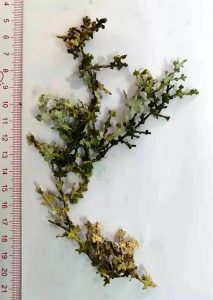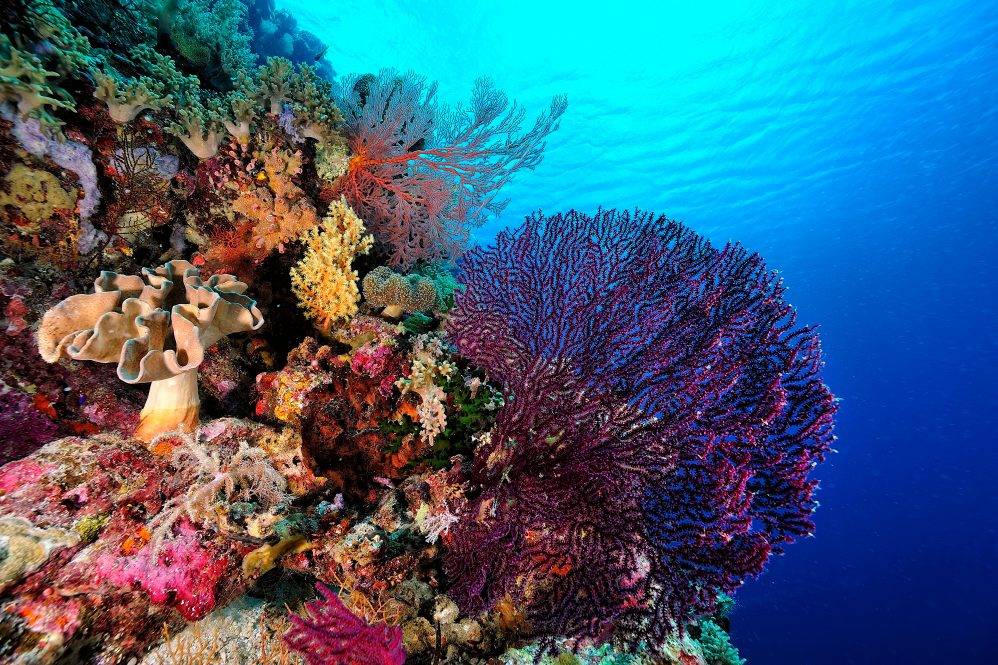A team of researchers including Department of Marine Sciences Professor Senjie Lin have for the first time sequenced the genome of Halimeda opuntia, and they found several surprising details about this strange, not-so-little algae. Their findings are published in PNAS.
The cactus-shaped algae are unique in many respects, Lin says. They grow as single cells with many nuclei and are relatively enormous compared to other single-celled organisms, reaching sizes of up to a foot long. The algae live in tropical marine ecosystems where the species plays an important role in reef-building, but differently than corals do.
Lin’s lab studies the genomics of marine creatures like dinoflagellates and diatoms, and H. opuntia is the first green alga they have sequenced. Lin and his co-authors were interested in looking at the species’ genome to try to understand how and why it evolved to have these unique characteristics.
“It’s a high-quality sequencing and assembly, and we were able to reconstruct the structures of the chromosomes and find what type of functions they harbor in the genome,” says Lin. “H. opuntia is unique, because usually when you think of an organism, it’s either a unicellular or a multicellular, but in both cases, they are uninucleate, meaning that one cell would have only one nucleus.”
A cell’s nucleus typically divides in a process called mitosis, where genetic material is duplicated and evenly divided before the single cell becomes two, then two cells become four, and so on. This process is carefully controlled and utilizes many specialized proteins to ensure everything goes smoothly, and the nucleus will not initiate the division process until cell division is complete. With H. opuntia, the researchers discovered the genome lacks the gene for an important protein that helps position cellular contents before cell division. The results give insight into some puzzling questions, like how H. opuntia grows into such relatively giant cells containing so many nuclei.

“We found that in the H. opuntia genome, they have all the myosins, except myosin VIII,” says Lin. “We checked the genomes of other organisms and found that other species of unicellular, multinucleate species also lack this protein, and that suggests the absence of this gene at least contributes, if not it is, the sole reason for the formation of the peculiar form of an organism.”
This was an exciting finding and brought the researchers one step closer to understanding some of H. opuntia’s unique qualities. The next piece of the puzzle they focused on was the evolutionary timing of some of these genetic peculiarities.
“When we looked more closely, we found that during evolution, the Halimeda genome duplicated, and it seems to have segregated into four sub-genomes. When we looked at the timeline of this evolution, we found that all the genome duplication events appeared to occur when there was a major change in the sea level and climate.”
Lin explains that this is consistent with previous findings which showed that genomes sometimes become duplicated as a way for organisms to adapt to stressful conditions.
“It is possible that Halimeda duplicated their genome to augment or heighten the capacity to cope with the stress of climate change.”
The next aspect of this peculiar alga that the researchers focused on was the capacity to process calcium from the environment into calcium carbonate, but in an entirely different way compared to how organisms like bivalves or corals perform this task.
“In most cases, calcification occurs within the cell of organisms, but these guys don’t do that. They calcify outside the cell where they form a structure that is like a little pocket called the interutricular space, where the calcification happens.”
Lin explains that pocket presents a fascinating and especially useful adaptation when thinking about today’s ocean, because, as atmospheric CO2 increases, more carbon is taken up by the ocean, which results in the ocean becoming more acidic. This change in pH, along with warming waters, creates unfavorable conditions for calcification, threatening coral reefs around the world.
“When we think about why they form the pocket, it means they can create an environment to keep the pH relatively stable via active photosynthesis and other unknown mechanisms,” Lin says. “They take up calcium from the environment and export it outside the cell to form the calcite structure that will protect and certainly strengthen the cell surface, and also support the characteristically long structure of the cell body.”
The caveat of doing this, Lin says, is that now the cell body is a bit gangly and brittle, so any turbulence in the water leads to portions of the cell breaking off. This leads to the next piece of the puzzle. Generally, when a single cell breaks, it dies, but that does not happen for H. opuntia, because the parts that break off can regenerate.
“We looked again at the genome to learn how Halimeda regenerates and see what kind of mechanism they have to do that. What we found were genes that are similar to those seen in plant wound healing processes, so it seems that they have a molecular toolkit to do this wound healing. This breaking off and regrowing also appears to be their way of reproduction, because a fragment can grow into a complete cell body again.”
Lins says the collaboration continues because there are questions yet to be answered, and many are timely, considering the urgency of climate change.
“There may be implications for coral conservation, maybe even to medicine in healing or tissue regeneration, but right now, we still know very little,” Lin says. “One thing that we would like to address immediately is whether Halimeda maintains a similar cell size to genome size ratio to other organisms and whether there’s any differential function of these sub-genomes or different nuclei, and how they contribute to the regeneration process. Because we are so concerned about climate change, the genome evolution data provides some food for further thought about whether we will see more genome changes in other organisms like what we see in this alga. A lot still needs to be studied.”



